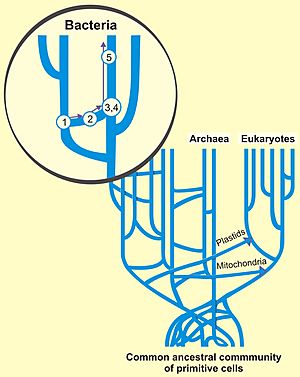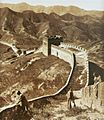Population genetics facts for kids
Population genetics is a science that looks at the genes within groups of living things. It combines ideas from genetics, evolution, and even mathematics. Scientists use math and computer models to understand how genes change over time. They also do field research to test their ideas in the real world.
Think of it like this: Population geneticists spend their time figuring out what genes are in a group of animals or plants. They also try to understand what forces are making those genes change.
Contents
How It All Started
The study of population genetics really began around 1902. Early scientists started to look at big questions about genes and how living things change.
The Hardy–Weinberg Law
Two scientists, G.H. Hardy and Wilhelm Weinberg, made a big discovery. They showed that if a group of living things mates randomly, and nothing else changes (like natural selection, new members joining, or mutations), then the mix of genes will stay the same forever. This idea is called the Hardy–Weinberg law. It was the first major finding in this new field. It gives scientists a basic rule to compare things to.
Connecting Darwin and Mendel
From about 1918 to 1937, population genetics grew a lot. Scientists like Ronald Fisher, J.B.S. Haldane, and Sewall Wright used new math tools, like statistics, to connect evolution (Darwin's ideas) with genetics (Mendel's ideas).
At the same time, E. B. Ford studied butterflies and moths (called lepidoptera). Theodosius Dobzhansky studied fruit flies (Drosophila). They did their research in nature. Their work helped prove that Mendel's ideas about how traits are passed down fit perfectly with Darwin's ideas about evolution. This important connection led to something called the modern evolutionary synthesis. This was a big agreement among scientists about how evolution works, happening from about 1937 to 1953.
Later Discoveries
In the second half of the 1900s, population geneticists looked at even more complex problems. They studied things like:
- Kin selection: Why some animals help their relatives, even if it puts themselves at risk.
- Mimicry: Why some animals look like other, dangerous animals to protect themselves.
- Molecular evolution: How changes happen at the level of DNA.
Key scientists in this time included John Maynard Smith, Motoo Kimura, and William Hamilton. The methods they developed also help us understand how much our heredity (what we get from our parents) and our environment (where we live) affect how we grow and develop.
Images for kids
-
The Great Wall of China can stop some land animals from moving between areas, which affects how their genes spread.
See also
 In Spanish: Genética de poblaciones para niños
In Spanish: Genética de poblaciones para niños





